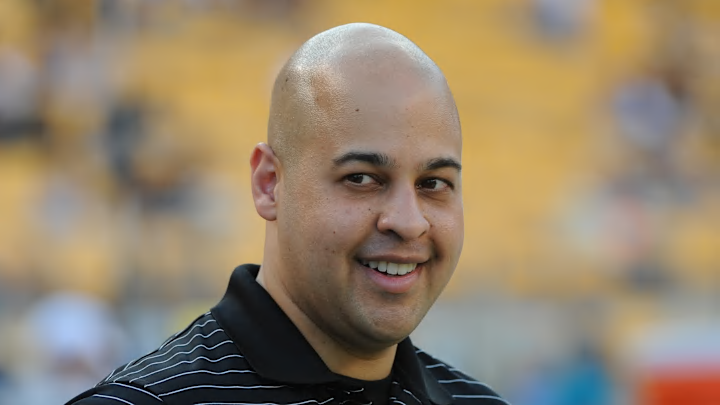The Pittsburgh Steelers third-round pick could end up being one that haunts them if Kaleb Johnson doesn’t emerge as a rightful successor to Najee Harris. Harris gained 1,000 yards in every season as a Steeler, but even he was found wanting throughout his tenure.
Johnson was a substantive prospect whose value fits Tomlin's ethos. As shown by the Steelers selecting Will Howard and Jack Sawyer, their strategy in later rounds rated productivity and physicality over combine measurements. The former Iowa Hawkeye rang up a 4.57 40, ran one of the slowest 10-yard splits at his position, and exhibited mediocre quickness and burst on film.
The Steelers selected Johnson over Virginia Tech Tech’s rocket-powered Bhayshul Tuten. Tuten ran a 4.32 40 and gained over 1,100 yards on the ground as a senior. However, Johnson gained 1,800 yards from scrimmage and scored 23 touchdowns as the feature back for a Hawkeyes offense that was the definition of banal.
If anyone should be perturbed about their production being overlooked by scouts, it’s not Tuten or Shedeur Sanders, it’s Cam Skattebo. Heading into the draft, Arizona State standout Cam Skattebo was often mocked as a Day 3 pick for the Pittsburgh Steelers. Instead, he fell to the New York Giants in Round 4 joining a pair of players spurned by the Steelers in Russell Wilson and Jaxson Dart.
Steelers fans wanted Cam Skattebo
Skattebo’s draft stock was hampered by his lack of burst and a 4.65-second 40-yard dash at the NFL Combine. He was available on the board for the Steelers in the third round. They preferred Johnson’s slow-as-molasses running back to be their feature back.
Johnson has been knocked for his lack of creativity and cut quickness, which could be a concern in a scheme that is reliant on ball carriers who possess excellent lateral quickness and vision. Johnson is a tough ball carrier to bring down when he’s racing down the gullet of the defense. But there are additional concerns about how easily he can be brought down. Pro Football Focus found Johnson forced just 66 tackles last season, the 13th most among running backs last season.
For how much he's praised for his tackle breaking, Kaleb Johnson seems to go down every time he's tripped. Just get a hand on his leg and you can bring him down. OL opens up a huge hole that could've been a massive run here. pic.twitter.com/gbzjyHTJ17
— JohnJohn Analysis (@JohnJohnalytics) March 20, 2025
Meanwhile, as a senior Arizona State’s wrecking ball of a running back was the premium subscription version of Johnson. Skattebo gained 2,316 yards from scrimmage, scored 24 touchdowns, finished fifth in Heisman voting, and was a superior receiver out of the backfield, reeling in 45 receptions for 605 yards as a senior.
In Arizona State’s Big 12 Title Game victory, Scattebo was a human pinball who displayed outlandish contact balance as would-be tacklers bounced off him like a trampoline. Johnson averaged half a yard more per carry than Skattebo, but the Sun Devils running back forced the second-most missed tackles (114) since PFF began tracking the stat in 2014.
Why Kaleb Johnson was the right pick
Johnson may not have the wiggle in tight spaces of a Zumba instructor, or the escapability of Skattebo, but he is built like a stereotypical power back who can power through arm tackles. At 6-foot-1, 225 pounds, Johnson is significantly stronger back than the 5-foot-11, 216-pound Skattebo. He's also more of an outside zone runner who can execute Smith's wide zone runs more effectively than Skattebo, who thrived on inside zone carries.
When discussing Johnson after the draft, Smith seemed to imply that Johnson possessed an extra gear in producing explosive runs.
“We want explosives,” Smith said. “You’re not just plodding, not just 2, 3, 4 yards (with) multiple third-and-2’s and third-and-3. You’d like to get those chunk plays.”
Johnson recorded 21 runs of 20 or more yards last season despite his sluggiest sprinter's speed. He was still the more conventionally attractive prospect and was recently flown in to visit the Steelers coaches and facility.
Meanwhile, Skattebo’s functional strength didn't translate to NFL Combine-style player evals which dropped him outside the top 100 prospects. It’s one thing for a prospect to run a 4.65, it’s another to do so as an average-sized back. The Steelers were surprised that Johnson was available for them in the third round and pounced in hopes that his strengths would translate.
In some respects, Iowa prepared Johnson for the Steelers beyond the color scheme. Kirk Ferentz’s unimaginative playcalling and subpar passing attack resulted in teams stacking the box against Johnson. He will face plenty of that if he spends his rookie year taking handoffs from Mason Rudolph in Arthur Smith’s zone scheme without the benefit of Iowa’s Avengers-tier offensive line. The Steelers saw a running back whose film indicated they can easily plug and play.
Both the Steelers' and Hawkeyes' rushing attacks were both heavily zone-oriented which would accelerate his integration into the offense. The Pittsburgh-Gazette found thatSports Information Systems charted Johnson running the 20th-most carries behind zone schemes in college football last season. His 6.5 yards per carry on those zone runs were the sixth-highest in college football.
Ultimately, the Steelers picked the consensus best running back remaining on their board. It’s a decision they feel comfortable living with or dying by.
